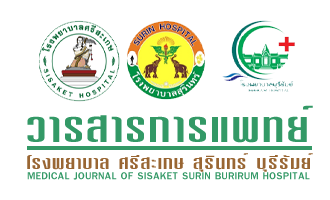โรคสครับไทฟัส (Scrub Typhus) ที่โรงพยาบาลบุรีรัมย์ : ศึกษาเปรียบเทียบลักษณะทางคลินิก และผลการรักษา
Main Article Content
บทคัดย่อ
วัตถุประสงค์: เพื่อศึกษาเปรียบเทียบอาการและอาการแสดง, ผลการตรวจทางห้องปฏิบัติการของผู้ป่วยโรค scrub typhus และ non scrub typhus และศึกษาผลการรักษาผู้ป่วยโรค scrub typhus
รูปแบบการวิจัย: การวิจัยเชิงพรรณา แบบศึกษาไปข้างหน้า (Prospective, Descriptive study)
สถานที่ทำการวิจัย: แผนกอายุรกรรม โรงพยาบาลบุรีรัมย์
กลุ่มตัวอย่าง: ผู้ป่วยที่รับไว้รักษาในโรงพยาบาลบุรีรัมย์ ระหว่างวันที่ 1 กันยายน 2546 ถึงวัน ที่ 30 พฤศจิกายน 2546 ด้วยปัญหาไข้สูงเฉียบพลันที่ไม่ทราบสาเหตุ (AUFI)
การวัดผล: การวิเคราะห์ข้อมูลเชิงพรรณา ใช้ร้อยละ ค่าเฉลี่ย ส่วนเบี่ยงเบนมาตรฐาน เปรียบเทียบข้อแตกต่างทั้ง 2 กลุ่มโดยสถิติ Mann - Whitney UTest
วิธีการศึกษา: ผู้ป่วยได้รับการซักประวัติ, ตรวจร่างกาย, เจาะเลือดส่งตรวจทางห้องปฏิบัติการ
ผลการศึกษา: ผู้ป่วยที่ศึกษาทั้งสิ้น 30 คนเป็นผู้ป่วย scrub typhus จำนวน 19 คน และ non scrub typhus จำนวน 11 คน แยกโดยวิธีการตรวจ Immunofluorescent Antibody (IFA)
เปรียบเทียบอาการและอาการแสดง กลุ่ม scrub typhus พบไข้หนาวสั่น สูงกว่าโดยพบได้ร้อยละ 73.7 (P = 0.015) ในขณะที่อาการและอาการแสดงอื่นๆ ไม่พบแตกต่างกันอย่างมีนัยสำคัญทางสถิติกลุ่ม non scrub typhus พบ กดเจ็บที่น่องสูงกว่าโดยพบร้อยละ 45.5 (P = 0.032)
เปรียบเทียบผลการตรวจทางห้องปฏิบัติการไม่พบความแตกต่างในการตรวจ
Complete blood count และ urinalysis พบความผิดปกติของ bilirubin และ ค่า Creatineมากกว่าในกลุ่ม non scrub typhus (P = 0.033 และ p = 0.034) ผลการรักษาไข้ลดลงภายใน 48 ชั่วโมงร้อยละ 78.9 หลังได้รับยา Doxcycycline
สรุปผล: การวินิจฉัยโรค scrub typhus จากโรคที่เป็นสาเหตุไข้สูงเฉียบพลันที่ไม่ทราบสาเหตุอื่น ๆ(AUFI) ยังไม่สามารถวินิจฉัยแยกโรคได้ชัดเจนโดยอาการทาง คลินิกหรือผลการตรวจทางห้องปฏิบัติการที่มีใช้กันอยู่ทั่วไป บางครั้งอาการไข้ในผู้ป่วยกลุ่มนี้จะรุนแรงและมีโรคแทรกซ้อนที่อาจเป็นอันตรายถึงชีวิตได้ การพัฒนาคุณภาพการตรวจทางห้องปฏิบัติการเพื่อให้การวินิจฉัยที่ถูกต้อง
Article Details
เอกสารอ้างอิง
2. Ogawa M, Hagiwara T, Kishimoto T, Shiga S, Yoshida Y, Furuya Y, Kaiho I, Ito T, Nemoto H, Yamamoto N, Masukawa K. Tsutsugamushi disease (scrub typhus) in Japan : clinical features. KansenshogakuZasshi 2001 May ; 75(5):359-64.
3. Brown GW, Shirai A, Jegathesan M, Burke DS, Twartz JC, Saunders JP et.al. Febrile illness in Malaysia :An-analysis of 1, 629 hospitalized patients. Am J Trop Med Hyg 1984;33:311-5.
4. Deller JJ, Russell PK. An analysis of fevers of unknown origin in American soldiers in Vietnam. Ann Intern Med 1967;66:1129-43.
5. Sangkasuwan V, Dechkunchom P, Prakobpanichkij B, Chuenchitra C, Chirasiri L, Onkasuwan K. Murine typhus :a report of 15 cases. J Med Assoc Thai 1973;56:175-8.
6. Feelarasamee A, Aswapokee P. Scrub typhus :report of two cases who seeked medication in Bangkok. Siriraj Hospital Gazette 1984;36:537-41.
7. Silpapojakul K, Woodtayagone J, Lakula A, Vimuktalaba A, Krisanapan S. Murine typhus in Southern Thailand. J Med Assoc Thai 1987;70:55-62.
8. Silarug N, Foy HM, Kupradinon S, Rojanasuphot S, Nisaluk A, Pongsuwant Y. Epidemic of fever of unknown origin in rural Thailand caused by influenza A (HI Nl) and dengue fever. Southeast Asian J Trop Med Pub Hlth 1990;21:61-7.
9. Silpapojakul K. Scrub typhus in the Western Pacific region. Ann Acad Med Singapore 1997 Nov; 26(6):794-800.
10. Silpapojakul K, Varachit B, Silpapojakul K. Paediatric scrub typhus in Thailand : a study of 73 confirmed cases. Trans R Soc Trop Med Hyg. 2004 Jun ; 98(6):354-9.
11. Watt G. Jongsakul K, Chouriyagune C, Paris R. Differentiating dengue virus infection from scrub typhus in Thai adults with fever. Am J Trop Med Hyg. 2003 May ; 68(5):536-8.
12. Song SW, Kim KT, Ku YM, Park SH, Kim YS, Lee DG, Yoon SA, Kim YO. Clinical role of interstitial pneumonia in patients with scrub typhus :a possible marker of diseases severity. J Korean Med Sci. 2004 Oct ; 19(5):668-73.
13. Thap LC, Supanaranond W, Treeprasertsuk S, Kitvatanachai S, Chinprasatsak S, Phonrat B. Septic shock secondary to scrub typhus :characteristics and complications. Southeast Asian J Trop Med Public Health. 2002 Dec;33(4):780-6.
14. Aung-Thu, Supanaranond W, Phumiratanaprapin W, Phonrat B, Chinprasatsak S, Ratanajaratroj N. Gastrointestinal manifestations of septic patients with scrub typhus in Maharat Nakhon Ratchasima Hospital. Southeast Asian J Trop Med Public Health. 2004 Dec ; 35(4):845-51.
15. Saisongkorn W, Chenchittikul M, Silpapojakul K. Evaluation of nested PCR for the diagnosis of scrub typhus among patients with acute pyrexia of unknown origin. Trans R Soc Trop Med Hyg. 2004 Jun ; 98(6):360-6.
16. Manosroi J, Chutipongvivate S, Auwanit W, Manosroi A. Early diagnosis of scrub typhus in Thailand from clinical specimens by nested polymerase chain reaction. Southeast Asian J Trop Med Public Health. 2003 Dec;34(4):831-8.
17. Jiang J, Marienau KJ, May LA, Beecham HJ 3 rd, Wilkinson R, Ching WM, Richards AL. Labaratory diagnosis of two scrub typhus outbreaks at Camp Fuji, Japan in 2000 and 2001 by enzyme - linked immunosorbent assay, rapid flow assay, and Western blot assay using outer membrane 56 - kD recombinant proteins. Am J Trop Med Hyg. 2003 Jul;69(1):60-6.
18. Won-Jong Jang, Myung-Suk Huh, Kyung-Hee Park, Myung-Sik Choi, Ik-Sang Kim. Evaluation of an Immunoglobulin M Capture Enzyme-Linked Immunosorbent Assay for Diagnosis of Orientia tsutsugamushi Infection. Clinical and Diagnostic Laboratory Immunology 2003 May;10(3):394-8.


